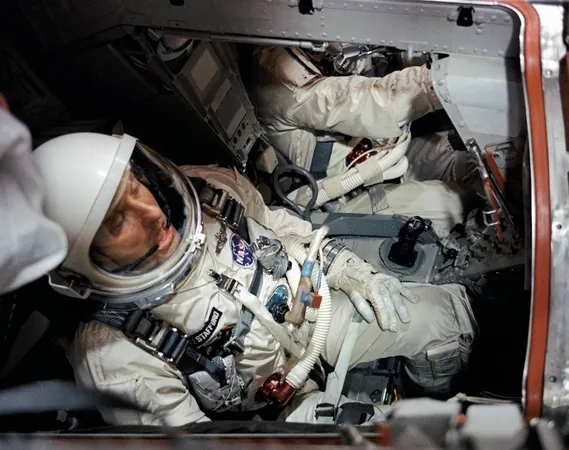
The Transformative Impact of Project Gemini on Space Exploration
2025-04-05
Author: Yu
The Birth of Gemini
Unlike its predecessor, Project Mercury, which heavily relied on automation, Gemini was revolutionary for entrusting pilots with more control. The spacecraft itself was small—just 80 cubic feet (2.27 cubic meters)—with astronauts often comparing the cramped cockpit to sitting sideways in a phone booth. The nickname “Gusmobile,” coined after Gemini 3 commander Virgil “Gus” Grissom, humorously highlighted the spacecraft’s snug fit, particularly for the shorter astronaut. Engineers had to make adjustments to accommodate taller astronauts like Tom Stafford, reflecting the unique challenges of designing equipment for human use in space.
The astronaut influence in shaping Gemini's operational design was significant. They pushed for dual hand controllers, enabling a more interactive flying experience. According to historians Barton Hacker and James Grimwood in NASA’s official Project Gemini history, this involvement reflected a deeper role for astronauts beyond mere flight; they became integral to mission planning and execution.
The intense training regimen prior to the missions was grueling; Grissom himself remarked on how time seemed to stretch impossibly. Among the 16 astronauts who flew the Gemini missions, many later journeyed to the Moon, demonstrating the rigorous selection process that favored skilled test pilots, engineers, and even academics.
The Art of Rendezvous
Gemini missions were crucial for mastering the complex maneuvers required to bring spacecraft together in orbit—a critical ability for future lunar landings where the Lunar Module had to dock with the Command Module. The early endeavors, however, were not without challenges. Astronauts struggled with visual estimations of distance, and a notable lesson from Gemini 4 highlighted the paradox of initiating rendezvous. Effective maneuvering required astronauts to adjust their orbit strategically, often defying their prior training in jet aircraft.
Gemini 6 made headlines in December 1965 when it achieved the first successful rendezvous with Gemini 7, coming within mere feet of each other in space. This astonishing maneuver showcased precise control and calculation, setting the stage for future missions that would require rapid adaptations in the event of emergencies.
Technological Triumphs and Human Ingenuity
The Gemini missions also underscored the significance of human decision-making amidst technological advances. During Gemini 8, Neil Armstrong and Dave Scott illustrated this when they docked with an Agena-D target spacecraft and were met with a life-threatening thruster malfunction. Their quick thinking and decisive actions were crucial in averting disaster.
By the time they reached Gemini 11, the team achieved a remarkable docking just 85 minutes post-launch, simulating emergency conditions pertinent to the Apollo missions. The heights they reached—850 miles (1,370 km) above Earth—remain some of the highest altitudes ever achieved by a non-lunar mission to this day.
Closing the Chapter of Gemini
Though not without complications, the Gemini missions consistently returned safely to Earth. Advances allowed for predictive landing approaches, and subsequent flights landed impressively close to intended targets—Gemini 9 notably splashed down a mere 2,300 feet from where they had aimed.
Ultimately, Project Gemini was more than a set of missions; it encapsulated an era defined by bold goals and collective determination. As astronaut Dave Scott remarked about the overwhelming drive of the program, they were 'running on adrenaline.' This pioneering phase not only brought the U.S. closer to landing on the Moon but also carved out a pathway that highlighted the indispensable role of astronauts in missions of great importance.
Today, as humanity embarks on new frontiers in space, the lessons of Project Gemini continue to inspire innovations and techniques that forge ahead into the next era of exploration. As we look toward missions to Mars and beyond, the spirit of Gemini reminds us of what can be achieved with collaboration, ingenuity, and a fearless pursuit of the unknown.


 Brasil (PT)
Brasil (PT)
 Canada (EN)
Canada (EN)
 Chile (ES)
Chile (ES)
 Česko (CS)
Česko (CS)
 대한민국 (KO)
대한민국 (KO)
 España (ES)
España (ES)
 France (FR)
France (FR)
 Hong Kong (EN)
Hong Kong (EN)
 Italia (IT)
Italia (IT)
 日本 (JA)
日本 (JA)
 Magyarország (HU)
Magyarország (HU)
 Norge (NO)
Norge (NO)
 Polska (PL)
Polska (PL)
 Schweiz (DE)
Schweiz (DE)
 Singapore (EN)
Singapore (EN)
 Sverige (SV)
Sverige (SV)
 Suomi (FI)
Suomi (FI)
 Türkiye (TR)
Türkiye (TR)
 الإمارات العربية المتحدة (AR)
الإمارات العربية المتحدة (AR)